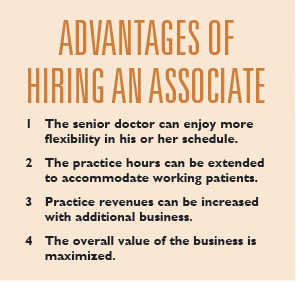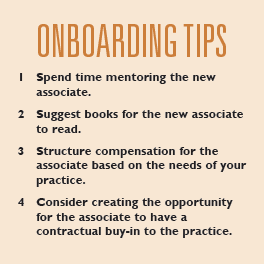
Considerations When Hiring an Associate Dentist.
According to the American Dental Association® (ADA), in 2016, more than 39 percent of dentists in active practice were aged 55 years and older. That statistic should be a reality check because after practicing dentistry for 20-plus years, many of us start feeling some aches and pains. A lot of experienced dentists feel pain in their backs and necks after repeatedly practicing dental treatments. At the same time, the dental practice is usually especially busy during these years because the dentist and his or her team has worked hard to build up a thriving business.
Some dentists, myself included, look forward to practicing dentistry well past the age of 50—in 2015, the average age of retirement (according to the ADA) was 68.8 years old. A lot of dentists who are pushing towards 70 years old still enjoy making a significant contribution to their patients’ well being, and want to keep their skills up to date.
Sometimes, though, older dentists fail to plan for a gradual easing of the workload, and mistakenly believe that maintaining a dental practice is an all-or-nothing commitment. When that happens, dentists often sell their practices quickly and may get less than the maximum potential value for the business. In addition, dentists miss out on an opportunity to mentor an associate dentist who can relieve some of the workload.
Having an associate dentist in the practice offers several advantages. One of the biggest advantages is having flexibility in the work schedule. As a senior dentist, it’s great to leave the office for a week or two and keep it running smoothly.

Some senior dentists bring on an associate not to cut back on hours or explore other professional opportunities, but to make a shift in the business model and go from six treatment chairs to twelve. There are many reasons to consider bringing an associate dentist into a dental practice.
HOW TO BEGIN
Hiring an associate dentist can be a win-win proposition because the practice can expand and bring in more revenue, the senior dentist can enjoy more flexibility in the schedule, and the associate dentist is mentored and perfects his or her skill set.
Keep in mind that some dental practices hire associate dentists as independent contractors, but that is a completely different situation. For questions about hiring an associate dentist as an independent contractor, I recommend speaking with experienced legal counsel to determine the best direction for such an arrangement.
Every dental practice is unique, so it’s important to do your research, consider hiring experts to help with the transition, and consult with legal counsel about all the requirements.
USEFUL METRICS
Some advisors suggest that dentists should consider bringing on an associate if the total practice revenues are over $1 million. Other key metrics include having the number of active cases between 1,600 to 2,000, and consistently getting 30 new patients a month into the practice.
Another important consideration is if your practice has not been advertising and you want to advertise to increase new patient flow. In that scenario, a new associate may be needed to perform the additional work generated from the ads.
If your practice hasn’t explored the possibility of expanding its practice hours and including weekend appointments, an associate dentist is a great way to increase business during those increasingly popular times. By actively growing your business with an associate, your practice could have the potential to bring in another million dollars.
MY EXPERIENCE
My wife, Dr. Nickie K. Lê, and I own a practice called LêDowns Dentistry, in Denver, CO. Our practice, like many typical dental practices, used to be open 32 hours a week. About a year and a half ago (in 2015), I noticed that many of our patients wanted to schedule appointments before or after their hours of employment, or on Saturdays. We weren’t always able to accommodate the patients who wanted those appointments because of several other obligations that I already had.
Therefore, some patients were either leaving treatment undone or were not being retained because they couldn’t get in for treatment. In general, patients delay or cancel treatment if they are not able to be seen within two weeks.
I acknowledged that our practice needed to bring in another doctor. I realized that, in order to make the transition a smooth one, I needed to start helping that doctor learn how to run a practice, how to talk to patients, and how to learn the varied skill sets involved in dentistry.

Fortunately, many young dentists are trying to crack into the business and establish themselves in the dental industry. Being mentored as an associate dentist is a great opportunity for young doctors to learn advanced skills from their more experienced and established colleagues.
FIND THE RIGHT FIT
After making the decision to bring on an associate, we embarked on the process of interviewing and talking to candidates to find someone with a set of professional values that matched those of our practice. It’s extremely important to find someone who is the right fit for your practice. We started actively looking about a year or so before we brought the associate on board.
I reached out to colleagues who were in the teaching world at universities and general practice residency programs. Eventually the dentist running the University of Colorado School of Dental Medicine in Aurora, CO, called me and said that he thought he had found someone.
Our first directive for the new associate was to ask him to start reading some books. Dr. Dick Barnes suggests that all dentists should read (and re-read multiple times) a book by Dale Carnegie—How to Win Friends and Influence People. The book, published in 1936, has sold over 30 million copies worldwide, and still offers valuable insights. Instructing a new dentist to read the book sends a signal that he or she is not just going to do dentistry, but will also learn how to build relationships with people. Of course dental skills are important, but the associate should be willing to learn people skills, too.
Furthermore, we enrolled our associate in the New Dentist’s Program with the Dr. Dick Barnes Group at Arrowhead Dental Laboratory so that he was committed to learning new skills. Investing in continuing education for associate dentists is a great way to keep them engaged and show them that you’re making a tangible investment right away.

MAKE IT WORK
Taking on an associate dentist is a process that usually has its highs and lows. It requires a lot of work and mentoring. Working with another dentist is very different than working independently, and it typically requires a paradigm shift for the senior dentist. The senior dentist must be able to mentor and case plan with the new associate so that he or she learns the process. It isn’t a matter of just hiring someone and turning them loose.
It’s important to have a plan in mind when bringing on an another dentist. It can take the new dentist as many as 10 years to get comfortable with the clinical aspects, and also with some of the management aspects. During that time, the associate dentist will need support from the senior dentist and the team.
With our new associate on board, I decided to work at the practice three days a week. So now I practice dentistry Monday through Wednesday, and our associate practices Tuesday through Saturday. When I started in dentistry, I was working six days a week.
Keep in mind that the senior dentist still has to show up and mentor the associate so that he or she doesn’t get lost and deviate from the established structure. To manage our team and mentor the new associate, I also come into the practice on Thursdays. During this time, I do skill-set trainings with my associate and team members. These trainings can cover verbal skills, treatment planning, or learning how to prep properly.
BE A MENTOR
Being a senior dentist doesn’t automatically give you the ability to mentor. I recommend reading The One-Minute Manager, by Ken Blanchard. This book is a great resource about how to mentor—how to direct and support someone, as well as how to let him or her discover their own potential.
My associate had completed two residency programs, so he was a senior resident during the second residency. As a senior resident, he taught junior dentists who were under his direction. When he started in my practice, he got “knocked down” a few times. Then I picked him up, told him what he did wrong, bailed him out, and showed him what to do.
I reiterated, “I believe in you. You’re in a different world now. This is the world of comprehensive dentistry, where you create relationships. You’re going to have to think a bit differently than you did before.”
After working with our associate for a year, he is really starting to catch on. Initially, there were some cases in which objections were raised that he didn’t know how to overcome, or questions were asked that he didn’t know how to answer, so he lost out on treatment.
Unfortunately, that means lost revenue, but the senior dentist should help the associate understand what happened and say something like, “Let’s talk about what you did that we can improve upon for the next case.” Eventually the associate will get some big cases and gain acceptance. The associate learns what works and what doesn’t work, and that builds confidence.
Another important consideration is facilitating the team’s acceptance of another practitioner. Helping the team learn to value and trust the associate dentist is important for any office.

COMPENSATION FOR YOUR ASSOCIATE
With regards to compensating an associate, a lot of doctors use a model where they pay on collection. It’s often structured one of two ways: either the senior dentist pays the associate 30 percent on collections, or the senior dentist pays 35 percent on collections, and then requires the associate to pay his or her own lab bill.
We discovered that if you pay the associate on collections, it takes almost three months to build up the collections, so we needed some sort of base pay for the first three months of the associate’s work otherwise, he (or she) wouldn’t have any money coming in. If your practice is not consistent at collections, it might take even longer for money to roll in from insurance company checks.
I’ve noticed that sometimes when dentists offer 35 percent of collections and the associates pay their own lab bills, an associate can be tempted to use a cheap dental lab. If you’re the senior doctor and you use a high-quality lab, then you might want to consider the 30-percent model, so that all patients receive the best quality dentistry, regardless of which practitioner they visit.
A third option is to devise a compensation method that is unique for your practice. In our practice, we use a tiered system based on production, and the business always pays the lab bill. A tiered system calculates payment based on the amount of production completed each day, and increases the payment percentage for the associate based on the overall level of production.
This system is simply a way to incentivize the associate. We want the associate to become increasingly proficient and to start doing comprehensive dentistry, and we also want him or her to use the best quality materials. This is why we structure our compensation in such a manner.
With a tiered system, the dental practice must have a good method for tracking each day’s total production. We use an Excel spreadsheet to calculate the incentive each day—one day the associate might get 28 percent, and 33 percent the next. There are some stipulations to the process. For example, if the dental practice is billing insurance, an adjustment has to be factored in.
Additionally, to get the associate going in the beginning, we double-booked hygiene appointments on a Friday or a Saturday, and the associate only checked hygiene visits that day. We paid him a standard amount (flat rate) on that day to show up and check hygiene.
That strategy gave the associate the opportunity to start building a client base. All the patients who showed up were basically new patients. And if the associate found work to do, then he (or she) could start building business for the next week. Now that the associate has been with us a year, he’s seen some patients two or three times. The hygiene checks were a big part of building his patient base.
MAKE IT A WIN-WIN
Something else to consider when taking on an associate is a contractual agreement for the transition and the eventual buy-in of the practice. Senior dentists with high-value practices should consider bringing on an associate who can be trained to eventually take over the practice. This strategy is designed to maximize the value of the practice.
I decided to invest my time and effort into such an arrangement because I want to capture the full value of my business, versus a doctor who has to sell his practice because he has health problems and needs to liquidate quickly. That doctor likely won’t capture the full value of his practice.
When you bring on an associate, the production of the practice increases. And when the production of the practice increases, so does the overall value of the practice.
Typically, a broker will use 60 or 65 percent of a dental practice’s collections to determine the value of that practice. Onboarding an associate with the intent of eventually having him or her buy the practice is a great way to maximize the value of your business.
Chrisad, a dental marketing agency, has been a great resource in helping us figure out how to structure this part of the agreement. It’s much easier for a new associate graduating from dental school with some associated debt to buy into a practice gradually, rather than try to buy it out completely.
By starting early, the associate’s equity grows as the practice grows in business. The associate can start putting money into the transaction at a very low level. The goal is for the senior dentist to eventually become the associate dentist and vice versa.
When the senior dentist is ready to stop practicing altogether, the associate dentist (now the senior dentist) can bring another associate in. By so doing, dentists can realize the maximum value for their dental practices.
With professional legal help, dental practices can structure arrangements that are beneficial for both senior and associate dentists. Of course, it requires official paperwork to draw up the details, but the paperwork also sets a framework for the level of commitment for the associate dentist. The agreement should include defined goals (and the consequences for achieving or missing those goals) for year five, year ten, etc.
SO FAR, SO GOOD
Having an associate dentist in the practice is beneficial for many reasons. He or she can add value to the business and give senior doctors some flexibility to decide how much and how long they want to work.
Some doctors get short-sighted and don’t want to deal with the process of finding and training an associate. But if a practice is so busy that patients can’t get in for treatment for three to four weeks, those are missed opportunities. Don’t sell yourself short or miss out on getting the maximum value for your practice. The payoff is worth the investment.









